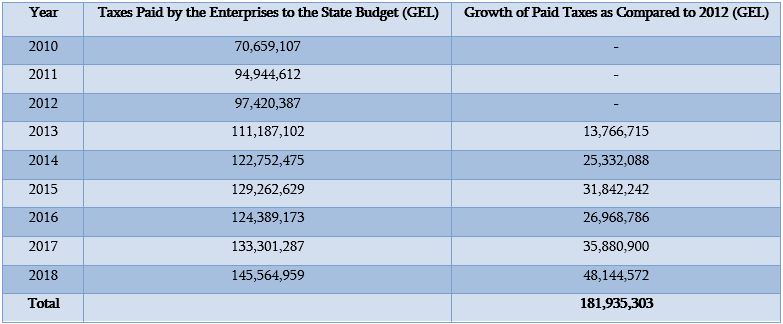Resume: As part of the Preferential Agro-Credit project, 200 new enterprises were opened and 940 were given a boost (expanded/refurbished). In the reporting period, the project budget exceeded GEL 260 million in total. In 2013-2018, 34,141 loans were issued with a total value of GEL 1,831,925.461. In those years, GEL 244,445,796 from the state budget was spent on co-funding the credit interest rate.
In 2013-2018, the total taxes of the Preferential Agro-Credit project beneficiaries, which they paid to the state budget, amounts to GEL 766,457,625 which does indeed exceed the money (GEL 244,445,796) spent by the state in the same period for co-funding the loans of the project’s beneficiaries. However, this comparison is principally wrong. Part of the enterprises used to work without the project and paid taxes nonetheless. Therefore, in order to measure the project’s effectiveness, it is appropriate to take into account the difference/growth in tax volume only as compared to the period before the project was implemented instead of the total amount of taxes.
In accordance with the statistics, taxes paid by the enterprises registered as taxpayers were GEL 97,420,387 in 2012. In 2013-2018, the average annual amount of taxes paid by the Preferential Agro-Credit project beneficiary enterprises was GEL 127,742.938 which is GEL 30,322,551 more. Therefore, the growth in the tax volume in the course of six years is nearly GEL 182 million which is substantially less as compared to the expenses made by the state. As a result of the state’s spending[1] of GEL 244,445,796, we received GEL 181,935,303 in benefit (in the form of tax money) which is GEL 62,510,493 less as compared to the money spent (in 2013-2018, enterprises paid GEL 181,935,303 more as compared to 2012).
The candidate for the Minister of Environmental Protection and Agriculture, Levan Davitashvili, in his speech before the joint Committee meeting, talked about the Preferential Agro-Credit project and stated: “Over GEL two billion in loans have been issued as part of the Preferential Agro-Credit project. State funding for the project is approximately USD 270 million. In regard to project effectiveness, the analysis has been made and additional taxes, which those enterprises awarded with funding as part of the project had paid, already exceed the money paid by the state.”
The Preferential Agro-credit project has been implemented since March 2013. The aim of the project is to increase the initial production, processing production and storage of agricultural products through the increased access to finance for agricultural entrepreneurs. Farmers and enterprises employed in agricultural production as part of the project receive preferential agro credits and agro-leasing from financial institutions for their fixed and liquid assets. At the same time, the Agriculture Project Management Agency (APMA) provides co-funding for the loan/leasing interest rate/leasing cost. The loan interest rate varies depending upon the loan volume and its aim.
Agro credits for fixed assets (fixed assets are assets at the disposal of enterprises which are intended to be used for more than one year. For instance: land, buildings and premises, machinery and equipment, transportation means, etc.) with the fixed and floating (changing) interest rates fluctuate between 6% and 16%. The interest rate for agro credits for liquid assets (assets which by their nature are short-term [current] and which are mostly intended for trade purposes or for other short-term goals) fluctuates between 4% and 16%.
In the case of fixed assets, the APMA provides 11% co-funding for servicing the interest rate for no more than 66 months.
In the case of liquid assets, the APMA provides 8% co-funding for loan service from 12 to 36 months, depending upon the aim of the existing loan.
In accordance with the official data, 200 new enterprises were launched as part of the Preferential Agro-Credit project in 2013-2018 whilst 940 were reinforced (expanded/re-equipped). In the reporting period, the project budget exceeded GEL 260 million in total. In 2013-2018, there were 34,4141 loans issued with a total value of GEL 1,831,925.461. In those years, GEL 244,445,796 from the state budget was spent on co-funding the credit interest rate. In the same reporting period, nearly 12,600 new jobs were created as a part of the project.
Taxes paid by the Preferential Agro-Credit project beneficiaries to the state budget in each year are as follows:
Table 1: Taxes Paid by the Preferential Agro-Credit Project Beneficiaries (only beneficiaries registered as taxpayers) to the State Budget (2010-2018)

Source: Ministry of Finance
With the aim of measuring the effectiveness of the Preferential Agro-Credit project, it would also be appropriate to compare the value of the project beneficiary companies’ production to the total added value produced by the country. This kind of comparison would give a more precise picture in order to assess the project’s effectiveness. However, the project has not been analysed in this way.
[1] Of note is that the growth of tax money cannot be stipulated by the aforementioned project’s impact alone. Tax volume had a growth trend even before the project.







